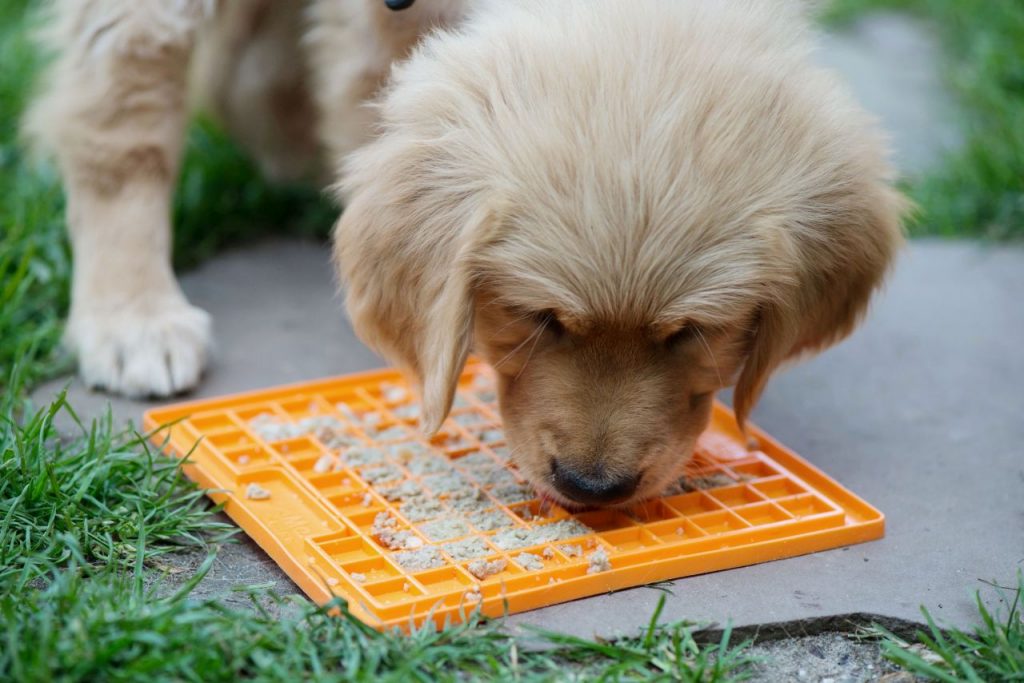
Nutrition:
There are various types of dog food available, including raw meat diets (self-prepared and ready-made fresh meat/KVV), freeze-dried food, air-dried food, wet food, and dry food (kibble and dinner).
But what is the best food for your dog? You can read more about this on Voerwijzer.
Initially, it’s important to feed the same food as the breeder for the first few months.
Our adult dogs and puppies are fed KVV (complete raw meat food) from the organic brand Darf. Besides fresh meat, we also introduce the puppies to Darf Vol kibble (cold-pressed dry food), raw fish, vegetables, fruits, and raw bones.
When feeding raw dog food, it’s important to maintain good hygiene. Use stainless steel or glass bowls and wash your hands, etc.
Feeding Schedule:
- 9 weeks – 6 months: 4 times a day (between 125 grams and 400 grams of KVV per meal, depending on the dog’s weight and needs)
- 6 months – 12 months: 3 times a day
- From 12 months: 2 times a day
Treats:
There are many different treats available for dogs, and you can also make your own. Pieces of vegetables or fruits, regular food like kibble (e.g., during walks or for searching in the grass/snuffle mat), or steamed meat (e.g., in a Kong or on a Lickimat) are fine to give in moderation. Pieces of dried meat or fish can also be given sparingly, such as during training, and you can dry meat yourself using a dehydrator. Try to limit processed treats, especially in the first year. Use primarily their own food as rewards and deduct that amount from their meals.
Prevent becoming overweight. Golden Retrievers usually love food and can be prone to gaining weight, so this needs extra attention. The amount of food indicated on the packaging is often too much for a Golden. Ensure that your growing puppy is not burdened with excessive body weight.
Grooming:
The Golden Retriever has a medium-length coat that requires some care. In addition to visiting a good groomer at least twice a year, you also need to take care of your dog’s grooming. It’s very important to introduce puppies to grooming from a young age, starting with short sessions and gradually increasing. Make sure it becomes a positive experience for your dog.
- Trim the nails with a nail clipper or dremel twice a week.
- Comb out the long parts of the coat and around the ears and armpits once a week. Check the teeth, provide things to chew on, and/or brush the teeth regularly.
- Trim the hair on the feet and clean the ears with a cloth (not inside the ear canal) twice a month.
- Bathe once a month with a good shampoo. Dry the dog with a towel, then use a cotton bathrobe or a water blower.
- Visit a groomer and osteopath at least twice a year for optimal coat care and physical health. It’s good to introduce puppies to the groomer around four months old with a puppy session.
Titer Testing and Stool Examination:
Our puppies are titered at 6 and 9 weeks. Puppies will return at 12 and 15 weeks for further titering if necessary, and then you can continue with a veterinarian from the list of titering vets. Three to four weeks after the vaccination, a final titer test checks if the vaccination has taken effect. After that, titer testing is needed only after a year and then every three years if the values are good. This minimizes the vaccine burden, ensures timely vaccination, and checks for actual protection. Ideal.
From 2-3 weeks, the puppies are dewormed every 2-3 weeks. You should continue deworming at 12 weeks and then follow the schedule, but it’s better to first conduct a stool examination since preventive deworming isn’t possible. You can send the stool sample 2-4 times a year for testing, for example, through Het Woud.
Neutering Spaying (Males and Females):
Opinions on neutering vary, and perspectives have changed significantly in recent years, both behaviorally and medically. Sometimes there’s a medical reason to neuter, but there are also many medical and behavioral disadvantages. Be well-informed before considering such a significant surgery and avoid neutering too early. You can read more about the pros and cons of neutering here.

